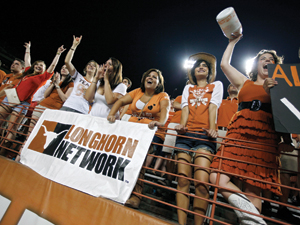The most important sports media story of the year will occur this fall when as many as six high-priced sports channels will be looking to gain cable and satellite carriage in various U.S. markets: college channels like
Longhorn Network and the
Pac-12 Network, plus regional sports networks in Houston (
Comcast), Los Angeles (
Time Warner), New Orleans and San Diego (both
Fox).
The question of whether these channels are successful will be a big indicator for the future market of sports rights.
If we use the past five years as a gauge, it’s likely that most of these networks will find significant carriage after public — and sometimes bruising — battles. Most of these channels already have some carriage deals in place.
 |
Longhorn Network is among as many as six sports channels that will be looking for carriage deals in big markets this fall.
Photo by: GETTY IMAGES
|
But I sense that distributors are prepared to fight this fall as a way to try to keep their own sports rights in control. Already, Longhorn Network and
Fox Sports San Diego are having trouble getting full carriage. Others are certain to have fights, too.
In private conversations at a cable industry convention in Boston last month, cable operators complained about the cost of sports channels — as they always do. But rather than complain about established channels like ESPN, Fox Sports or NBC, they mainly pointed the finger at these new channels looking to launch.
Their main complaint is that they feel they are being asked to pay twice for the same programming. They complain that the University of Texas and ESPN, for example, have sliced up programming packages too much. In past years, distributors paid for channels that carried all of Texas’ football games. Now, they are being asked to pay more — about 40 cents a subscriber per month — for another channel that has two Texas football games. If they don’t pay, they don’t get the channel.
So far, the channel, which is owned by ESPN, has not had any traction. A source said that ESPN and Time Warner Cable have not even discussed the network in months. And DirecTV Chairman, President and CEO Michael White told an investor conference earlier this month, “We have not put the Longhorn Network on, and have no plans to.”
It’s not just Longhorn Network that is causing this ire. Take Los Angeles, for example. By the end of the year, Los Angeles will have five regional sports networks — more RSNs than any other market in the country. In addition to the two that already exist from Fox, Time Warner Cable is planning to launch two for the Lakers and the Pac-12 is planning to launch one around UCLA and USC.
For cable or satellite operators in Los Angeles that means that the cost for local sports will just about double this year. This fall, it would cost about $10 a subscriber per month to carry all of those networks. According to SNL Kagan, the two Fox RSNs (Prime Ticket and FS West) now cost a little more than $5.
In the past several years, the blueprint for rights holders has been to cut ownership deals with distributors as a way to guarantee carriage and success. That’s what the Lakers have done with Time Warner Cable. The Pac-12 announced significant cable carriage deals. And Fox has deals with Cox in New Orleans and San Diego.
But that strategy is not foolproof, and some distributors are fighting back.
Perhaps the biggest concern for programmers and rights holders may be recent public comments from the head of DirecTV, the satellite company that has become known for cutting sports deals early. Speaking at that investor conference, White made it sound like he was prepared to fight carriage battles this fall to keep his programming costs down.
Specifically, he said he didn’t know what DirecTV would do with Time Warner’s planned channels. He said DirecTV has question marks about the Pac-12 channels, though he added, “We’re not going to have seven [Pac-12] channels, I can assure you that.”
My guess is that most of these channels will be successful eventually. But distributors have grown weary of paying huge increases on these channels and are looking to claim at least one scalp. The question is if that scalp gets claimed this fall.
John Ourand can be reached at jourand@sportsbusinessjournal.com. Follow him on Twitter @Ourand_SBJ.





